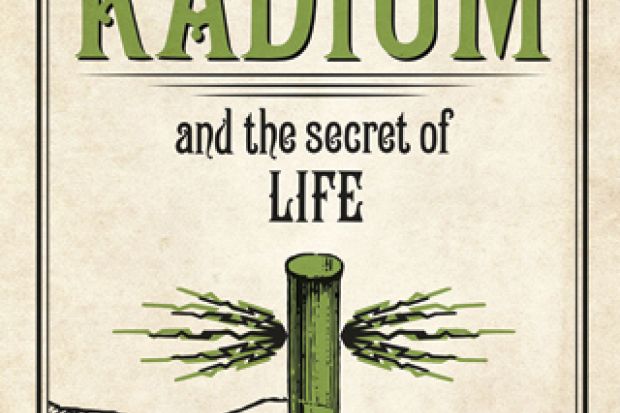When Pierre and Marie Curie discovered radium at the end of the 19th century, they gave the world something it had never before encountered or even dreamed of. This self-glowing magical substance promised to be a source of limitless energy. I remember seeing a series of cigarette cards from 1899 with predictions of what life would be like in the year 2000. One showed a lovely scene with a family (still stuck in their Victorian dress) gathered round the fireplace in the parlour, warmed only by a lump of radium in the grate. In the first decades of the 20th century, radium was the magic ingredient in plenty of quack cures; my favourite has always been the Radioendocrinator, a gold-plated radium-containing harness that could be worn in a variety of fashions, including under the scrotum in a special jockstrap in order to help enervated males.
While these sound unbelievably crazy today, they simply highlight how little was understood about radioactivity, and particularly its effects on life. Luis Campos’ Radium and the Secret of Life examines not only the early research using radium on living material, but goes much further, examining the parallels that were made between the processes of radiation, as typified by radium, and those of life itself. As its author, a historian of science, announces, “at another level, the book is also a novel experiment in historiographical form in that it seeks to treat ‘radium’ not only as the subject of the book and as an object that life scientists discussed and worked with, but also as the narrative conceit and immanent analytic for the book as a whole”.
This statement of intention highlights what I found to be the least enjoyable part of Campos’ book – the introduction. Written in a style that I suspect the majority of readers would find inaccessible, it certainly left me scratching my head. I was dreading having to read through to his “theoretical coda” at the end of the book, where, Campos promises, he will suggest that “this is what a hermeneutic of transmutation, seriously attempting to deploy ‘radium’ as an epistemic tool for the historian as much as it was for the scientist, might look like in the form of historical narration”! Thankfully, however, the intervening chapters are easier to comprehend and contain much of interest.
Apart from the obvious “half-life”, I had never previously thought about the language of radioactivity and its parallels in the processes of life, as expressed, for example, in the notion that the heaviest of elements, uranium, thorium and radium, were “unfit to survive” and had “limited lives”, and how it was almost through a kind of natural selection that these “parents” gradually “decayed” to their stable “daughter elements”. I particularly liked Campos’ mock-biblical quotation about the construction of atomic family trees: “Now Thorium begat Uranium, and Uranium begat Radium, and Radium begat Helium and Polonium, and Polonium begat Lead”. He also obligingly notes some of the crazier speculative uses of radium, including an account of a farmer in 1903 who wondered whether, if he mixed some of the self-heating element with his chicken feed, “the radio-eggs would either hard-boil themselves upon being laid, or would hatch the chicks without need for an incubator”.
The real story of the book, however, begins with radium being used to explore the origins of life itself via the experiments of J. B. Burke, who reported in 1905 from the Cavendish Laboratory in Cambridge that adding radium salts to the sterilised medium of beef gelatine produced half-living pseudo-organisms he called “radiobes”. With all the subsequent media hype, Burke was to become “the most talked of man of science in the United Kingdom”. Sadly, his radiobes were soon shown to be most likely nothing more than bubbles or tiny crystals.
But even if it were not the cause of life, radium was soon shown to be able to induce the mutations so necessary for the process of natural selection, and comparisons were made between the seemingly random decay of a radioactive nucleus and the appearance of genetic mutations. Campos describes early investigations using radium on plants such as the evening primrose and then jimson weed (Datura stramonium) before moving on to the biologist’s favourite organism, the fruit fly (Drosophila). Although Hermann J. Muller was to receive his 1946 Nobel Prize in Physiology or Medicine predominantly for work in causing mutations in fruit flies using X-rays, he had started off, and had never quite given up, using radium as his alchemical source of transmutation – with the switch to X-rays coming only after his precious shipment of radium salts was broken and lost during transit.
Overall, this is a scholarly book, thoroughly researched. But you might want to skip the intro, though.
Radium and the Secret of Life
By Luis A. Campos
University of Chicago Press, 352pp, £38.50
ISBN 9780226238272 and 8302 (e-book)
Published 21 April 2015
Register to continue
Why register?
- Registration is free and only takes a moment
- Once registered, you can read 3 articles a month
- Sign up for our newsletter
Subscribe
Or subscribe for unlimited access to:
- Unlimited access to news, views, insights & reviews
- Digital editions
- Digital access to THE’s university and college rankings analysis
Already registered or a current subscriber? Login





